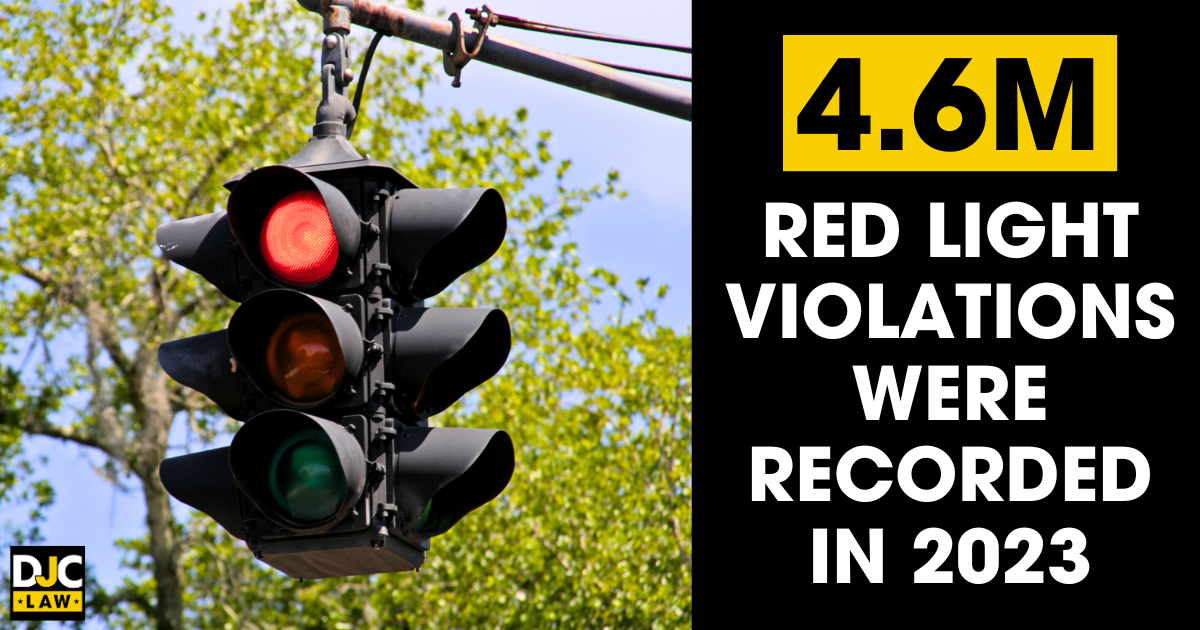
Right-on-red laws are a facet of many states, allowing drivers to turn right at a red light. In Texas, you’re allowed to turn right at a red light, but like so many traffic laws, this isn’t a universal law. Certain circumstances prohibit turning right at the lights, and some roads may ban the practice entirely.
Understanding Texas’ right-on-red laws is crucial, as Verra Mobility’s data demonstrated that there were more than 4.6 million red light violations in 2023. It’s a practice that can have devastating consequences, with CarsDirect reporting that 20% of accidents are caused by drivers running red lights. If you’ve been involved in an accident caused by a red-light violation, consulting an experienced Austin car accident lawyer can help protect your rights.
Today, we’ll discuss Lone Star State’s position on the practice and what drivers must know before taking that right turn.

Key Takeaways
- Texas permits you to turn right at a red light legally unless a sign otherwise prohibits right turns or a local ordinance is in place.
- Making a legal right turn at a red light requires you to come to a complete stop and yield to all crossing pedestrians and oncoming traffic.
- Dead red laws are in effect in Texas. You’re still permitted to make a right turn, but all inactive traffic signals must be treated like a stop sign, meaning you must come to a complete stop.
- Turning right at red lights may be banned if there are high volumes of pedestrian traffic, complicated intersection layouts, or safety experts have detected a high rate of accidents due to the practice.
- The rule on turning right at red lights has been criticized by some safety experts as contributing to more accidents, particularly those involving pedestrians.
- Speak to an attorney if you’re hit by someone when turning red at a red light to ensure you receive the compensation you deserve.
Can You Make a Right Turn on a Red Arrow in Texas?
Texas law allows you to make a right turn on a red arrow. However, you must come to a complete stop unless there’s also a sign that prohibits stopping or a sign that prohibits right turns entirely.
The general rule of thumb is that a red arrow should be treated like a stop sign if you’re going to make a turn. We recommend stopping entirely for at least three seconds before making the turn.
Note that before turning, you must yield the right of way to any pedestrians who might be using a crosswalk or lawful traffic using an intersection.
What is the Dead Red Law?
Dead red laws exist in Texas under the Texas Transportation Code 544.007. Under this law, all drivers must yield to any traffic lights that aren’t functioning because of power outages. Inactive traffic signals represent a significant danger, so they must be obeyed even when they aren’t working.
The Lone Star State mandates that frozen, dark, or flashing red lights are treated like stop signs. In other words, you must come to a complete stop and then use due care to navigate around the signal.
Don’t buy into the popular myth that if a red light isn’t working, you can breeze past it like it wasn’t there.
Legal Framework for Right Turns on Red in Texas
Texas traffic laws allow you to turn right on red, but drivers must take certain steps to ensure their turn is legal. This includes coming to a complete stop, stopping in the right place, yielding to oncoming traffic, and crossing pedestrians.
Here’s the basic legal framework for right-on-red laws:
- Stop Completely – You must come to a complete halt. A rolling stop doesn’t count. We recommend stopping for at least three seconds to make it clear that you’ve obeyed the law.
- Know the Stop Line – Don’t enter the crosswalk. If your vehicle is on the stop line or past it, you’re breaking the law and putting pedestrians at risk.
- Check for Signs – Turning right on red is a general law, not a universal one. Some intersections have signs that ban turning right on red. In all cases, these signs take precedence.
- Yield Properly – Before turning, you must always yield the right of way to any pedestrians who are crossing the road or any oncoming traffic.
Situations Allowing Right Turns on Red
Right turns on red are the default on Texas roads. Unless there’s a sign preventing you from doing it, assume you’re allowed to turn right on red. It’s a rule that covers most Texas roads.
Other states may have different rules on the issue. For example, many states ban turning red if a red arrow is present. These states include:
- Alaska
- California
- Colorado
- Georgia
- Idaho
- Maine
- Minnesota
- Nebraska
- Nevada
- New York
- North Carolina
- Vermont
- Virginia
Exceptions: When “No Right on Red” Signs Are Posted
Any sign prohibiting right turns on red must be obeyed. Municipalities opt to put these signs up in situations where roads are dangerous, there’s limited visibility, or it’s a particularly complex road.
The motivation behind many of these exceptions often relates to pedestrian safety. According to the Texas Department of Transportation, even though 99% of traffic accidents don’t involve pedestrians, they still represent 19% of all road deaths. In 2023, 808 pedestrians died on Texas roads.

Other scenarios include:
- Limited Visibility – Some intersections are notorious for accidents because drivers don’t have a clear view of other traffic. It’s these roads where right turns may be prohibited.
- Complicated Traffic – Busy roads with challenging traffic patterns, such as roads with multiple lanes, may have these signs placed to avoid confusing drivers and making navigation more complex than it needs to be.
- Safety Concerns – In the past, some roads have seen these signs crop up because of a high crash rate. If safety experts deduce that right turns have become a significant risk contributor, these signs might appear as an additional safety measure.
Implications of Turning Right on Red: Safety and Legal Consequences
Right-on-red laws have been criticized for reducing traffic safety for all road users. According to ITS International, a 1984 review found that motor vehicle crashes increased by 23%, pedestrian crashes grew by 60%, and cyclist crashes more than doubled after intersections permitted right turns on red.
It’s why more and more municipalities nationwide are reducing the number of roads where this practice is allowed. Other countries have long outlawed the practice over safety concerns, too.
As the driver, there are potential legal consequences for making these turns. It’s your duty to pay due care and attention when performing this maneuver, including coming to a complete stop and yielding the right of way appropriately. Breach your duty of care, and you could assume blame for the accident, resulting in fines, increased insurance premiums, and even criminal action.
Potential Penalties for Illegal Right Turns on Red
Making an illegal right turn on red is a Class C misdemeanor. If found guilty, you will be issued a fine. The maximum fine is $200 for all traffic violations of this nature, but the precise amount depends on where the offense happened.
Although the fine may not sound like anything significant, there are other costs to consider. Firstly, these violations go on your driving record, impacting your insurance premiums – potentially hundreds of dollars annually.
Common Scenarios Leading to Accidents While Turning Right on Red
Some of the most common situations that lead to accidents when turning right on red include not coming to a complete stop, misjudging speed/distance, and not correctly accounting for oncoming traffic.
Here are some of these scenarios in action:
- Not Yielding – The turning driver must yield to all pedestrians and oncoming traffic. If you don’t yield, the chances are both parties may continue on their way, as is their legal right, thus resulting in an accident.
- Misjudging Speed/Distance – Drivers may underestimate the distance and speed of oncoming vehicles. Such drivers may turn too quickly, thus not giving oncoming traffic enough time to take evasive action.
- Not Stopping – Sadly, many drivers don’t come to a complete halt and simply slow down. This results in other road users not having enough time to react to your actions.
The most common types of accidents are broadsides or T-bones, where another vehicle smashes into the side of another. At high-speed intersections, this could come with deadly consequences.
Understanding Right Turn on Red from a Pedestrian’s Perspective
Pedestrians must also understand the legal right of way to keep themselves safe. Pedestrians always have the right of way over drivers attempting to make a right turn on red. But that doesn’t necessarily substitute for awareness.
Before crossing a road where right turns are permitted, pedestrians must ensure the driver has seen them. Assuming the driver has already seen you on roads with limited visibility or other obstructions is a recipe for disaster.
Ensure the driver has seen you and watch their behavior before crossing to keep yourself safe.
Are There Instances Where You Can Legally Turn Left on Red in Texas?
Roads that allow left-hand turns at a red light are relatively rare in Texas. Generally, you can’t make a left turn on a red light apart from in some specific situations.
Under Texas law, you’re only allowed to perform this maneuver if you’re taking a turn from a one-way street into another one-way street. Downtown areas will usually put up signs where this is allowed.
If you encounter one of these roads and want to make a left turn, the same rules apply as making a right turn on red. You must come to a full and complete stop and yield to oncoming traffic and pedestrians.
Comparative Overview: Right Turns On Red In Other States
Right turns on red are legal in nearly all states. It’s a long-standing practice, with states in the west allowing it for more than a half-century. Eastern states have largely amended their traffic laws to allow the practice in the 1970s.
Eastern states got on board with the practice due to the fuel shortages in 1973. The reasoning behind the rule is that it reduced fuel consumption by lowering how far drivers had to travel.
States With Prohibited Right Turn on Red Laws
No state prohibits right turns on red as a blanket policy. Different regions and municipalities have their own rules in place, though.
New York City is the biggest exception to the rule. Generally, the city will prohibit red light turns and require you to wait for a green light, unless otherwise stated. According to New York City’s traffic rules, you may only perform the maneuver if you see a sign explicitly stating it.
The District of Columbia has also followed NYC’s lead on the issue. They have a whole set of rules under the DC Municipal Regulations Title 18, Section 4013. Areas where right turns on red are permitted include intersections that fit the following criteria:
- Failure to provide minimum sight distances.
- Unconventionally shaped intersections.
- Intersections with significant pedestrian traffic.
- Intersections with high numbers of elderly and child pedestrians.
- Intersections with controlled crosswalks.
All states may also have local ordinances in place passed down by authorities like the county’s commissioner’s court. Always ensure you’ve checked the laws if you’re driving in an unfamiliar area.
How Right Turn On Red Laws Affect Traffic Dynamics Nationally
The U.S. is one of the few countries in the world that allows right turns on red. The introduction of these laws has had a significant impact on traffic flows, fuel efficiency, and environmental impact.
These changes include:
- Reduced delays for traffic at intersections.
- Decreased idling time.
- Smoother traffic flow.
- Reduced congestion.
- Lower emissions.
- Superior miles to the gallon.
What Should You Do After a Car Accident Caused by an Illegal Turn On Red?
If you were involved in an accident that wasn’t your fault due to someone making an illegal right or left turn on red, it’s vital that you follow the proper steps to preserve any future personal injury claim.
Follow these steps in the aftermath of your accident:
- Call 911 and ask for an ambulance (if there are any serious injuries) and a traffic officer to attend.
- Exchange insurance and contact information with any other parties who were involved.
- Take photos of the accident scene. Ensure you get photos of visible injuries, vehicular position, and damage to each vehicle.
- Gather eyewitness statements, if any are present.
- Wait for a police officer to fill out an official accident report.
- Visit your nearest ER for a medical examination. Traumatic injuries like concussion, internal bleeding, and whiplash may not immediately display symptoms.
- Tell your auto insurer that you were involved in an accident. You’re obligated to do this under the terms of your policy.
The final step is to contact an experienced car accident lawyer to discuss legal representation and your next steps for making an insurance claim and possibly filing a personal injury lawsuit.
Importance of Legal Representation in Right Turn Accident Cases
Always hire an experienced personal injury lawyer as soon as possible after an accident. Per statistics from Nolo, those who hire an attorney receive up to four times more in compensation than those who represent themselves.
Lawyers perform various functions, including:
- Gathering evidence.
- Building your case.
- Filing legal paperwork.
- Negotiating with auto insurers.
- Providing objective legal advice.
- Filing lawsuits against the other driver.
Remember, an attorney doesn’t just handle the nuts and bolts of your claim. They also provide peace of mind, allowing you to focus on recovering from your injuries. Above all, they’ll leave no stone unturned in their pursuit of maximizing your settlement package.
If you’re ready to make a claim against an at-fault driver, get in touch with Austin’s premier law firm at DJC Law. Contact us now for your case consultation.


